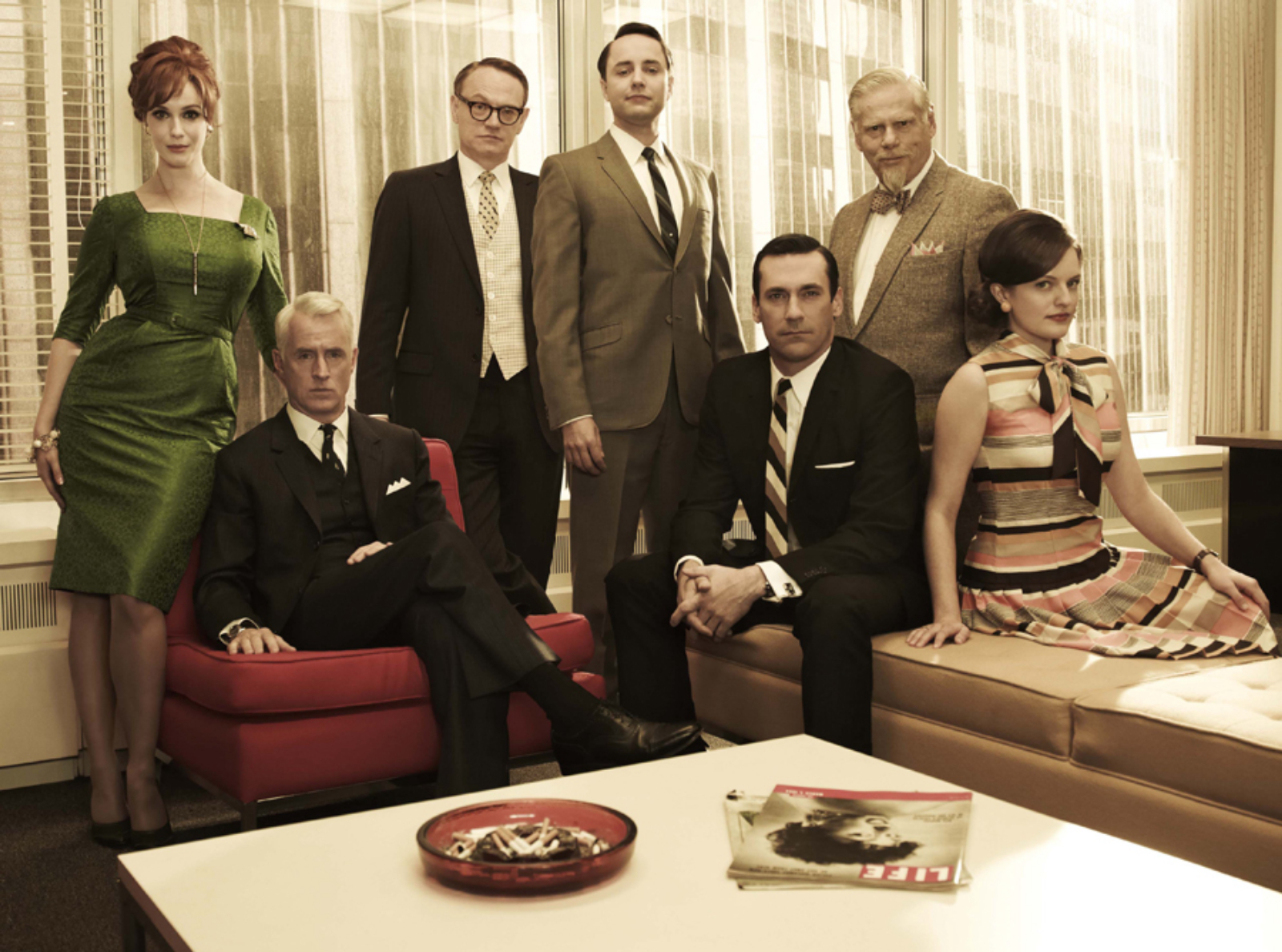By: Emily Rinaldi
AMC’s fifteen time Emmy Award winning series, Mad Men, has become the pop culture standard for everything 1960s. From fashion to interior design, Mad Men spawned a renewed interest in the period.
The show centers on a New York advertising agency, Sterling Cooper and its evolution into Sterling Cooper Draper Price. Season one opens on the year 1960 and season five ends in the year 1967. Creator Matthew Weiner and the show’s production crew work tirelessly to ensure that every detail of the series is in line with the time period. From the clothes, the drinks, the language, the art, Weiner combs over everything down to the smallest details. Historical narratives, like the demolition of Penn Station featured in the aptly named episode “Love Among Ruins,” place the events of the show within familiar history, but are far from being the driving force of the show’s plot. Michael Wilson of the New York Times writes, “Mad Men uses historical events as props to drive the running soap opera among its characters.” Events like John F. Kennedy’s assassination or the Cuban Missile Crisis take a back seat to romantic intrigue.

(Image Right: Time Life Building)
For a show that has everything to say about 1960s fashion, interior design, and commercial advertising, what does Mad Men have to say about architecture from that same period? In the show’s fourth season, the office of Sterling Cooper Draper Price moves to the thirty-seventh floor of the Time & Life building at 1271 Avenue of the Americas between West 50th Street and West 51st Street. Wilson describes the choice as being “the perfect location for an upstart firm nurturing an image of being cutting edge.” “Upstart” because Sterling Cooper can no longer be considered “Mad Men” of Madison Avenue and “cutting edge” because it would have been a fashionable to be located in the newly built tower for the magazine publishing power house, Time, Inc.
The Time & Life building opened in 1959 and was the first structure of the expansion of Rockefeller Center west of Sixth Avenue. Rockefeller architect, Michael M. Harris, of Harrison, Abramovitz & Harris, designed the structure. A masterpiece of mid-century modernism, the tower is a product of the advances in steel frame architecture and glass curtain wall construction. At forty-eight stories high, Time & Life is a sleek example of post-World War II office tower design. Hidden behind its glass and steel exterior, is an expertly executed coordinated aesthetic that permeates the entire building. Several different designers participated in the construction of Time & Life’s interiors, Alexander Girard designed the ground floor restaurant, Gio Ponti, the 8th floor auditorium, William Tabler, the corporate dining rooms, Charles Eames, the Time magazine reception area, and George Nelson & Company the Hemisphere Club and Tower Suite. However, the building’s shinning achievement is its lobby, a designated New York City landmark.

The Time & Life lobby is one of those preservation success stories that you rarely hear about, a perfectly preserved mid-century modern interior. White marble and plate glass cover the outer walls, while the elevator core is wrapped in stainless steel panels. The terrazzo floor is laid in a serpentine pattern, curvilinear lines contrasting starkly with the unornamented walls. Murals, Relation Painting #88 by Fritz Glarner and Portals by Josef Albers, are still displayed in the east and west corridors, installed on the outer walls of the service core.
(Image Left: ground floor interior, east corridor; via: Carl Forster for NYC Landmarks Preservation Commission)
Yet, despite this perfect preservation of period design, you would never see the characters of Mad Men entering their office building through the Time & Life lobby. Although the show is set in New York City, Mad Men is actually filmed in Los Angeles. Outdoor scenes are not filmed on location, but are set against locations that look vaguely like New York. For example, in season three, characters enter and exit their Madison Avenue office building via the lobby of L.A.’s Unocal Building, rather than a building actually on Madison Avenue. Because the show is filmed so far from where it is actually set, shots of tall skyscrapers are brief, if at all shown. Therefore, Weiner and his crew work hard to cultivate the mid-century style of the interior. Their attention to detail is thorough, period pieces and products lovingly arranged in every shot. If you look closely in season four, you will even see Eames’ Time- Life Chair strewn around the offices of Sterling Cooper, chairs Eames specially designed for the Time & Life lobby.
With such a wealth of good design at their fingertips, it is a shame that Mad Men relies so heavily on invented interiors rather than those that actually existed within the time the show is set. Because much of the setting is staged, the show’s influence on the preservation movement for architecture of the 1960s is unclear. While this renewed interest in mid-century modernism is certainly encouraging, the implication suggested by Weiner and his Mad Men is that a good copy can be used as a stand in for the original. This is just Hollywood, elaborate period costumes and CGI spectacles; therefore, the show does not really have much to say to organizations like Docomomo US who are working for the built, not the simulated. The mid-century modernist design is merely creating a setting with a distinct style just as the references to historical events provide context; each helps to ground the show within the time period. In reality, Sterling Cooper Draper Price would not have only furnished their office with pieces by well-known designers such as Eames just as all important historical events of the 1960s would not have touched these characters lives so personally. While it is unlikely that all the interiors the characters find themselves in would have looked as Mad Men would have us believe, it is nice to revisit these design masterpieces, even if it is only just fantasy.
